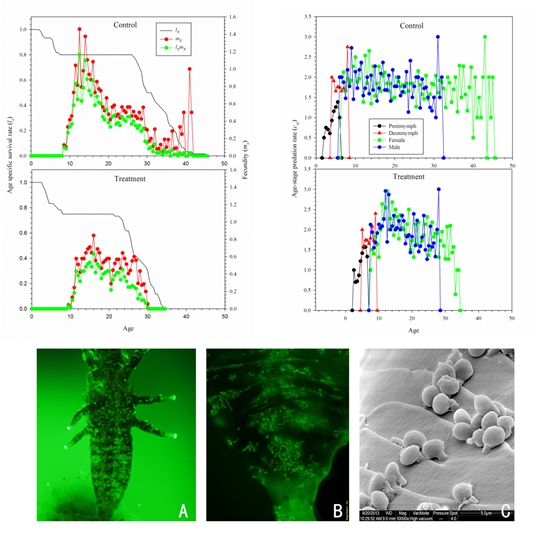分享到
Feeding on Beauveria bassiana-treated Frankliniella occidentalis causes negative effects on the predatory mite Neoseiulus barkeri
The entomopathogenic fungus Beauveria bassiana and the predatory mite Neoseiulus barkeri are both potential biocontrol agents for their shared host/prey Frankliniella occidentalis. The combination of the two agents may enhance biological control of F. occidentalis if the fungus does not negatively affect N. barkeri. However, the potential benefits and hazards of using fungus and predators simultaneously have not yet been widely evaluated. Therefore, a better understanding of the interactions between fungus and predators will improve their integration into pest management practices.
Recently, researchers at State Key Laboratory of Plant Diseases and Insect Pests, Institute of Plant Protection of CAAS have published a research paper on Scientific Reports about risk evaluation of indirect effects of B. bassiana strain SZ-26 on predatory mite N. barkeri. The study showed that B. bassiana has indirect negative effects on N. barkeri population dynamics via influencing their prey F. occidentalis larvae, and the biological parameters of the predators, including the mean generation time (T), net reproductive rate (R0), finite rate of increase (λ), intrinsic rate of natural increase (rm) and predation were affected. The findings indicate that there is a risk in combining B. bassiana with N. barkeri simultaneously for the biocontrol of F. occidentalis. The probable mechanism for the negative effects is discussed.
 More details are available on the bellow links:
More details are available on the bellow links:
http://www.nature.com/srep/2015/150708/srep12033/full/srep12033.html
Recently, researchers at State Key Laboratory of Plant Diseases and Insect Pests, Institute of Plant Protection of CAAS have published a research paper on Scientific Reports about risk evaluation of indirect effects of B. bassiana strain SZ-26 on predatory mite N. barkeri. The study showed that B. bassiana has indirect negative effects on N. barkeri population dynamics via influencing their prey F. occidentalis larvae, and the biological parameters of the predators, including the mean generation time (T), net reproductive rate (R0), finite rate of increase (λ), intrinsic rate of natural increase (rm) and predation were affected. The findings indicate that there is a risk in combining B. bassiana with N. barkeri simultaneously for the biocontrol of F. occidentalis. The probable mechanism for the negative effects is discussed.

Biological parameters of the predatory mite N. barkeri in control and treatment (Control means feeding on untreated F. occidentalis; Treatment means feeding on B. bassiana-treated F. occidentalis)
http://www.nature.com/srep/2015/150708/srep12033/full/srep12033.html
By Shengyong Wu
sywu@ippcaas.cn
sywu@ippcaas.cn
Latest News
-
 Apr 18, 2024Opening Ceremony of the Training Workshop on Wheat Head Scab Resistance Breeding and Pest Control in Africa Held in CAAS
Apr 18, 2024Opening Ceremony of the Training Workshop on Wheat Head Scab Resistance Breeding and Pest Control in Africa Held in CAAS -
 Apr 03, 2024IPPCAAS Co-organized the Training Workshop on Management and Application of Biopesticides in Nepal
Apr 03, 2024IPPCAAS Co-organized the Training Workshop on Management and Application of Biopesticides in Nepal -
 Mar 28, 2024Delegation from the School of Agriculture and Food Science of University College Dublin, Ireland Visit to IAS, CAAS
Mar 28, 2024Delegation from the School of Agriculture and Food Science of University College Dublin, Ireland Visit to IAS, CAAS -
 Mar 25, 2024Director of World Food Prize Foundation visited GSCAAS
Mar 25, 2024Director of World Food Prize Foundation visited GSCAAS -
 Mar 20, 2024Institute of Crop Sciences (ICS) and Syngenta Group Global Seeds Advance Collaborative Research in the Seed Industry
Mar 20, 2024Institute of Crop Sciences (ICS) and Syngenta Group Global Seeds Advance Collaborative Research in the Seed Industry
